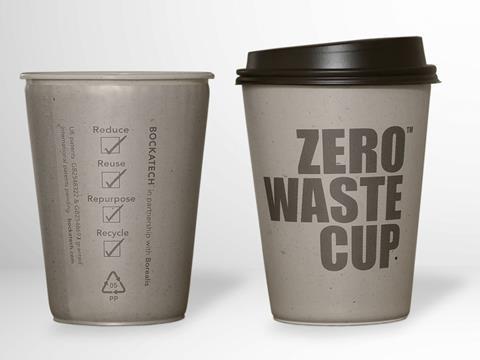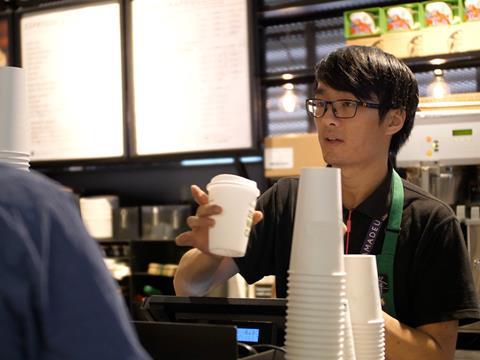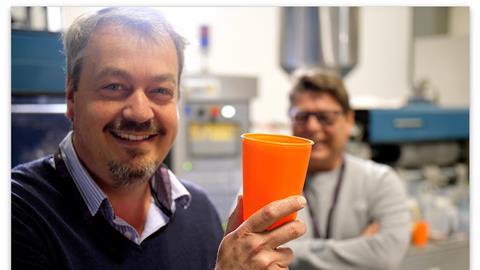The march towards reusables continues — and UK-based start-up Bockatech has been working on a reuse model for coffee cups around its patented EcoCore® plastics manufacturing technology. Victoria Hattersley spoke to company founder Chris Bocking and Director Martin Blacher to find out what makes their approach to reusables different.
Five years ago UK-based start-up Bockatech was established with the purpose of bringing its patented technology, EcoCore, to market. EcoCore is a new technology that produces injection-moulded packaging — for food service, FMCG, industrial and healthcare — with PP skin-foam-skin walls ‘almost instantly’. The company has ongoing partnerships with global polyolefins producer Borealis and in-mould labels expert Verstraete, among others, to bring this technology to the market.
The sustainability challenges faced by the packaging industry are many and varied, as we all know only too well, and Bockatech believes EcoCore can address several of these with its light weight, insulation, durability and recyclability. But right now, one mammoth problem the company is focusing on is the mountain of waste resulting from our reliance on takeaway single-use paper beverage cups. And to do this, it favours a reuse and recycle approach.
‘A new area of reuse’
It’s all very well, of course, talking about reuse and recycle but what does this mean in practice? According to Chris Bocking, firstly the EcoCore coffee cups have been designed with light-weighting in mind but, “Because of the process we use to expand the material the structure is very strong so we can offer this more traditional light-weighting without sacrificing strength.”
Secondly, and more strategically, is the reuse. Bockatech chose to develop the first application for its technology as a low cost insulated reusable coffee cup because of the lack of recycling of PE-lined paper cups.
The cup consists of skins either side of very low-density foams. The foam core allows the thickness of the walls to be increased while using the same amount of material — hence the lighter weight. This skin-foam-skin structure, according to Bockatech, also has practical benefits for the consumer in that it can keep the contents of the cup hot or cold for longer, can protect the hands from being burned and is more robust for reuse.
“As for producers, the key element to this — what drives down the cost — is the foaming that creates a very stiff structure,” says Martin Blacher. “People are looking for an alternative to single-use paper at a price point that’s similar. We’re pretty much there — injection moulding is all about cutting weight and cycle times to drive costs down, and we have got short cycling and increasingly lighter weights so we’re approaching parity with paper.”
It’s also worth taking a look here at the environmental savings Bockatech is claiming for EcoCore’s production. The LCA Centre in the Netherlands compared EcoCore reusables against popular single-use dual wall lined PE and PLA compostable paper cups and the results showed a 20–30% reduction in CO2eq after just two uses. After 30 uses the reduction in CO2eq increases to 80–85%. In addition, reusing a cup just twice halves the risk of land and sea litter pollution whilst thirty uses would see this figure cut to 1/30th.
Then there is the recyclability aspect. “Obviously mono-PP cups like ours are widely recyclable. This means, alongside the reuse, our model has closed loop potential. We are seeing some move towards the use of our tech in place of foamed PS as well as PE-lined paper” says Chris.
But as with all PP products, the barrier to a truly closed loop system is the lack of food-safe recycled PP similar to what has been achieved with PET. At the moment EcoCore packaging for food service is produced using virgin materials so recaptured plastic will be used in anything from coat hangers to card underbody parts. But when plastic manufacturers are able to supply food-grade PP recyclate at quantity, the CO2 savings would of course filter down to Bockatech and its partners. When this happens it’s going to be big news for everyone.

In Europe EcoCore cups are now manufactured by Miko Pac and have been trialled successfully. The town of Shrewsbury in Shropshire, UK, has implemented a scheme to make reusable takeaway cups using the technology available at the point of sale in cafes with a £1 refundable deposit. When returned, the cups are washed for reuse. A local supermarket in Shrewsbury carried out tests which showed they could still be used after 1000 cycles in a commercial dishwasher. Chris says this has already drawn interest from other towns looking for new ways to tackle the problem of packaging waste. NHS Scotland and Paardekooper Group have also successfully run reusable schemes using the technology and cups can be found in many Little Waitrose stores.
Reuse is a ‘continuum’
The above examples show that EcoCore can work for reuse in real-world settings, but these are individual cases and it will naturally be a bigger challenge to ensure its adoption on a larger scale. Arguably, one of the stumbling blocks to a wider adoption of reuse models is the perceived lack of convenience as compared to single-use. Of course, there will always be the more eco-conscious consumers who are prepared to go the extra mile, but we have to be realistic and accept that not all consumers — as yet — have bought into the concept of reuse.
This is why, says Martin Blacher, it’s time to think differently about what reuse really means in practice. Rather than being an all-or-nothing, he suggests we think of it as a ‘continuum’ — a spectrum on which there are different degrees of reuse models — with those that can be used tens or even hundreds of times, to those that may only even be used twice.
“People traditionally think either single-use or reusable. But reusable systems aren’t necessarily for reuse thousands of times. We can also make very lightweight cups that will only be reused, say, 10 times. And consider this: even if you reuse an EcoCore cup once you are cutting CO2 by 20 – 30% and halving the risk of a container leaking into the environment, as long as it’s recyclable. That’s a huge difference.”
With the very lightweight EcoCore model, Chris and Martin say the reuse would typically be between 2 – 30 times. The strategic purpose behind this is to make reuse convenient for consumers to the point where suppliers can provide reusables in place of single-use with little to no financial impact. What is needed is to capture the majority — not preach to the converted. “We’re trying to make it both environmentally and economically viable to make the default path reuse.”

Taking on a ‘service role’
However, it’s important to remember that it’s not just consumers who can be resistant to change — some elements of the industry may also be guilty of this, too. A supplier of single-use plastics, for example, may have understandable reasons for keeping their supply chain the way it is. And on one level, of course recycling is highly important, but if we focus solely on this it only sustains the existing supply chain and leaves no room for new modes of thinking — like reuse.
This is where being a start-up, with a fresh outlook on the market, can help to blaze a trail. “If you’re not part of that game you can look at things in a different sense and consider what is best for the environment. You can go back to the start and really make reuse economically viable. Being small, we get to envisage a new future and create products for that.”
To do this, the supply chain needs to adapt. “You see it with all disruption: unless companies adapt they are not economically viable anymore, but a lot are still viewing it through defensive eyes rather than seeing it as an opportunity to move into new areas. For example, suppliers can alter their model to take on more of a service role — carrying out the collection, washing, etc. — than a linear one. The Ellen MacArthur Foundation estimate converting just 20% of plastic packaging into reuse models is a USD 10 billion business opportunity” It is those companies that can display this agility, he argues, that will survive.
‘An approach that works for today’
What’s fundamental about reuse / recycle models like Bockatech’s is that, while they are certainly forward-thinking and require something of a change of mindset, they do still work within current market realities. While many compostable packaging materials — to give just one example of an alternative — undoubtedly have huge potential for the future, we don’t yet have the large-scale infrastructure in place for more sustainable use. And while this may happen in time, Chris and Martin would argue that what is needed is an approach that works for today.
“It’s important that reuse and recycling doesn’t require large-scale change to be effective,” explains Chris. “With, say, PLA or compostables if you look at the LCA of these it’s still really high: PLA lined cups are coming out with a higher impact than PE cups because they go to curbside waste and only a small percentage are actually composted so the rest are going to landfill or being burned. For this to work, there would need to be huge, systemic changes in the waste process across the world.”
Covid — ‘a question over safety?’
Of course, this year has been an anomalous one for all of us, to say the least. In light of the Covid-19 pandemic, some have expressed concerns — whether for genuine or for political reasons is of course not for me to say — that reusable packaging may not be the safest option.
Given the scope of our conversation thus far, I was of course interested to hear Bockatech’s take on this. Is there any chance the pandemic could hold back the ‘reuse revolution’?
“I would say it has been a slight negative but nothing catastrophic,” says Chris. “It’s understandable that there’s a question over safety; is it a pathogen that can transfer? It’s good to see this concern and to have these kinds of questions being asked and meaningful discussion, but ultimately if the washing process is carried out correctly then you don’t have a problem. And one of the necessities for a good reuse scheme is that the washing of containers is monitored correctly — look at Loop, for example. And then, think about the amount of things we reuse currently — cutlery, to name just one. We’ve been happy with the safety of those so why would we not be happy with the safety of reusable packaging?” It’s a fair question.
‘No single solution’
The global waste problem we face is multifaceted and frankly daunting, so there is of course no single answer; rather, as we have often said, it will require a plethora of solutions. But focusing on individual issues — such as takeaway coffee cups as Bockatech has — seems a valid approach.
We can’t point the finger of blame solely at the coffee chains for this growing mountain of waste: we’re all culpable: users and producers, and it falls on everyone to do their part. And to give them their due, many of the biggest high street coffee chains, as we have seen, have indeed recognised their responsibility and are beginning to explore various models — reuse, biodedgradable and so on — to address it. Making reuse convenient for consumers would be a good step forward. To do this, the industry may indeed turn to companies like Bockatech — small, agile start-ups with no vested interest in the established supply chain.
“We’ve got a very interesting technology that can massively assist both light-weighting and supporting the transition to reuse in a way that not many reusable systems can offer,” says Chris. “But it’s important to note we’re not manufacturers. Our business model is to partner with the converters and brand-owners. We would then license the people with the right market access who know the product requirements and we marry our tech with their systems to come up with a new range of products that use EcoCore.
“What we need is converters to approach us to deploy products to serve their markets.”
Will we see this applied on a wider — even a global — scale? What I believe EcoCore has in its favour is the potential scalability — it is, after all, using the already-installed global injection moulding and recycling infrastructure. It’s an interesting approach to reuse and we’ll be keeping an eye on the company in the coming months to see how well this takes off.
















